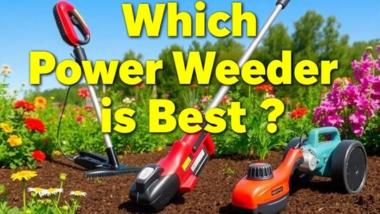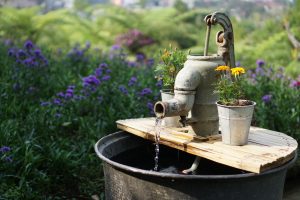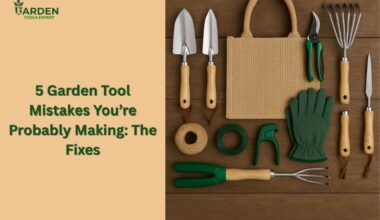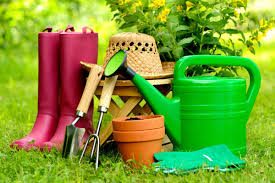Ever stepped on a rake and nearly lost your balance or worse, got smacked in the face? It sounds like cartoon slapstick until it happens in real life. You were probably missing out on these garden tool safety tips.

That image of a foot hitting a rake is a perfect reminder: gardening isn’t always as peaceful as it looks. One small mistake, and you’re limping back into the house instead of enjoying your time outdoors.
Gardening is therapy for the soul, but it can be a hazard zone for the body if you’re not careful. Beginner or a seasoned green thumb, these 7 overlooked garden tool safety tips could save you from injury (and embarrassment).
1. Wear the Right Protective Gear For Safety

Before you even step into the garden, make sure you’re dressed for safety. A good pair of gardening gloves is a must; they protect your hands from thorns, splinters, and blisters.
Eye protection, like safety goggles, can shield you from flying debris when trimming branches or using power tools.
Don’t overlook your footwear either. Closed-toe shoes with non-slip soles will help prevent stubbed toes, slipping, or stepping on sharp tools.
2. Choose the Right Garden Tool for Your Task

It might be tempting to grab the nearest tool and dive right into your garden project, but using the wrong tool can do more harm than good. A pruner isn’t a saw, and a shovel isn’t a crowbar.
Misusing tools not only makes the job harder but can lead to muscle strain, damaged plants or tools, and even injury.
Check out 5 Garden Tool Mistakes and the Fixes for common tool errors and how to avoid them.
While having a “green thumb” matters, the real power behind great gardening often lies in the tools you choose. Dull shovels or rusty shears won’t just slow you down; they can also affect your plants’ health and your safety.
Investing in the right tools is not just about convenience. It is about helping your garden grow well. It also keeps you safe and efficient.
Always keep a range of reliable tools on hand, and don’t skip reading product instructions. The right tool for the job makes all the difference.
3. Maintain Your Tools Regularly
Poorly maintained tools don’t just slow you down; they can also be dangerous. Rusty blades can snap, dull edges require extra effort (increasing the risk of slips), and loose handles may break without warning.
One of the most overlooked garden tool safety tips is regular maintenance. Just a few minutes of care after each gardening session can make a big difference.
Rinse off digging tools with a hose and use a wire brush or putty knife to scrub away dirt. Pruners and shears should be cleaned with soapy water and a nail brush to remove sap and grime.
If your tools touch sick plants or soil with pests, clean them with a diluted bleach solution or rubbing alcohol. Always dry them thoroughly afterward to prevent rust.
Condition wooden handles and protect metal parts with boiled linseed oil. For ongoing care, keep a bucket of sand mixed with oil nearby. Dipping your tools in it after use helps clean them quickly. It also provides extra rust protection.
And don’t forget the basics: sharpen blades regularly, oil moving parts, and tighten any loose screws. These simple steps improve performance and follow the best garden tool safety tips. This helps keep your time in the garden safe and productive.
4. Store Tools Safely and Securely
As part of important garden tool safety tips, store your tools properly. This helps prevent accidents and makes them last longer.
Designate a specific storage area, like a garden shed, and use hooks to hang sharp or long-handled tools. This keeps them off the ground and safely out of the way, reducing the risk of injury.
Looking to upgrade your storage setup? Our post on garden tool storage hacks is packed with smart, space-saving ideas worth checking out.
5. Use Proper Body Mechanics

Gardening can be just as physically demanding as a workout, so it’s smart to warm up your body beforehand. A short walk or light movement helps loosen your muscles and reduce the risk of strain. Stretching before you start can go a long way in preventing soreness.
As you work, be mindful of your posture. Gardening often involves bending, lifting, and repetitive movements, so it’s important to protect your body.
One important garden tool safety tip is to lift properly. Bend at your knees, not your back, when handling heavy items like soil bags or pots. Use a foam pad or garden kneeler to protect your knees during long weeding or planting sessions.
Alternate hands while pruning or weeding to avoid overuse injuries. Take regular breaks to stretch and stay hydrated; your body will thank you. And if you feel any discomfort after a session, applying ice can help reduce inflammation.
When lifting or moving heavy loads, always check the weight first. Divide them into smaller containers if needed, and use tools like wheelbarrows or garden carts to reduce strain. Practicing good techniques is one of the easiest and best ways to keep gardening fun and pain-free.
6. Avoid Overreaching or Working in Awkward Positions

Reaching for a high-hanging vine or trying to dig in a cramped space can throw off your balance and lead to falls.
Instead of stretching beyond your comfort zone, use tools designed to extend your reach or reposition yourself to stay stable. If needed, grab a sturdy step stool or garden ladder to safely access higher spots.
7. Survey Your Work Area for Hazards
Before you start digging or clearing, take a moment to inspect your surroundings. Check for hidden rocks, tangled hoses, sharp branches, or uneven ground.
Also, be careful of buried utilities when you plant deep. Call your local utility service to mark safe digging areas if needed. This might seem far-fetched, but this
Conclusion
Gardening is meant to be peaceful and rewarding, not a source of aches, slips, or surprises. While it may seem like a low-risk hobby, injuries can and do happen. The good news? Most are easily preventable.
By following smart habits and staying mindful of how you use and store your tools, you can make gardening safer, more comfortable, and a lot more enjoyable.
Remember: a healthy gardener makes for a happy garden. So suit up, gear up, and keep these garden tool safety tips in mind every time you step outside.
If you want to improve your safety skills, check out our guide on 5 Garden Tool Mistakes and the Fixes. Your back, hands, and knees will thank you..







